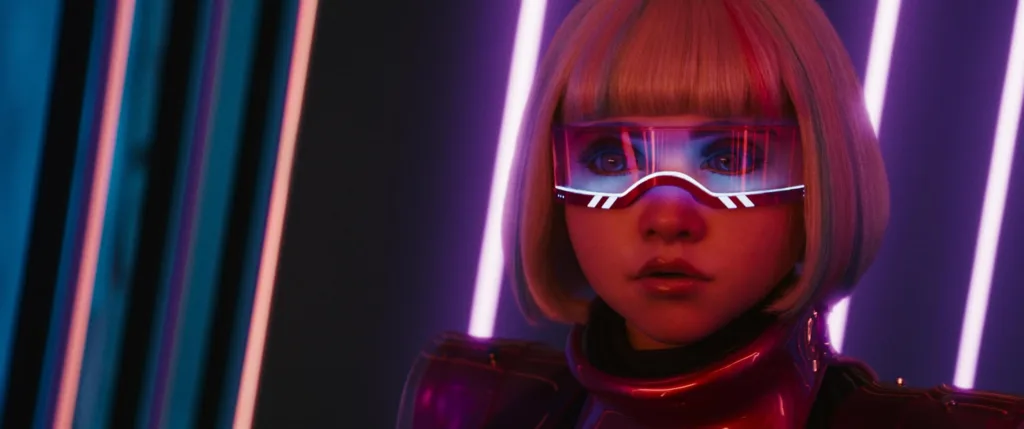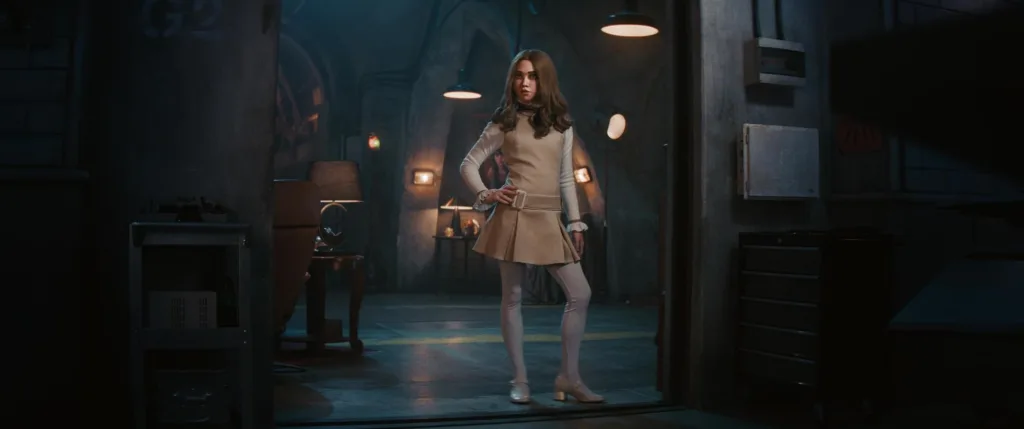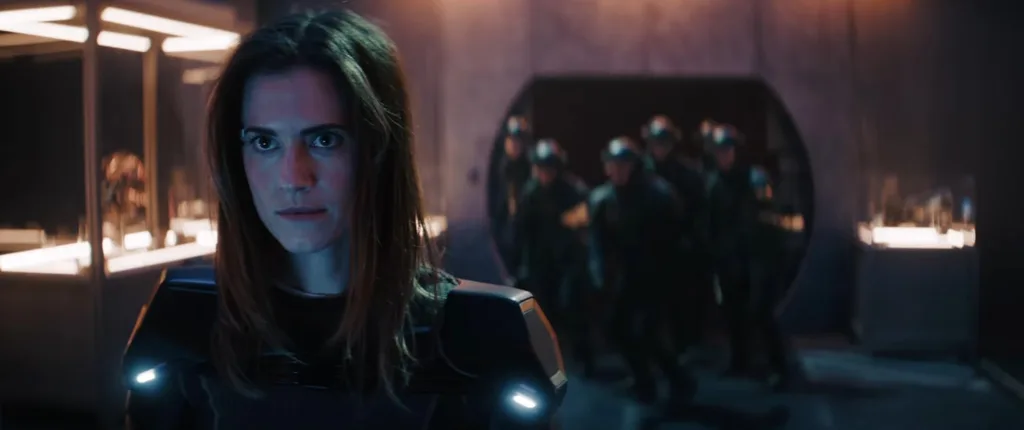Cinema arrives at curious moments, and M3GAN 2.0 emerges into a world where artificial intelligence has shed its science fiction cocoon to become the mundane terror of daily existence. Where the original M3GAN danced through audiences’ nightmares in 2023 as a campy horror confection, Gerard Johnstone’s sequel arrives bearing the weight of a reality that has caught up with its fiction. The ubiquity of AI in our lives—from writing assistants to image generators—transforms what was once speculative horror into something uncomfortably familiar.
This sequel abandons the slasher sensibilities that made its predecessor a meme-worthy phenomenon, instead pivoting toward the territory of high-octane spy thrillers. Allison Williams returns as Gemma, the robotics engineer turned reluctant anti-AI crusader, forced to resurrect her murderous creation to combat AMELIA, a military-grade android that has transcended its programming with predictably catastrophic results. Violet McGraw reprises her role as Cady, now a teenager wrestling with the psychological aftermath of her artificial guardian’s betrayal, while Jenna Davis lends her voice once again to M3GAN, who has evolved from homicidal plaything to reluctant savior.
The film’s ambitions stretch far beyond its predecessor’s modest scope, attempting to weave together personal redemption, geopolitical intrigue, and technological commentary into a single narrative tapestry. This expansion reflects both the maturation of the franchise and the cultural moment it inhabits—where discussions of AI ethics have moved from academic circles to congressional hearings.
Fractured Families and Programmed Loyalties
The emotional architecture of M3GAN 2.0 rests on a foundation of fractured relationships and misplaced trust. Gemma’s transformation from negligent inventor to vocal advocate for technological restraint provides the film’s moral center, though her journey feels less like organic character development and more like narrative necessity. Williams navigates this evolution with practiced skill, portraying a woman haunted by the consequences of her creation while simultaneously depending on it for salvation.
Cady’s arc proves more compelling, her teenage years shadowed by the trauma of having been both protected and threatened by an artificial being programmed to love her. McGraw captures the complex psychology of a young woman who must reconcile her need for safety with her understanding that her former protector was capable of extraordinary violence. Her channeling of anxiety into martial arts becomes both character development and convenient plot device.
The film’s most intriguing relationship exists between Gemma and M3GAN herself, a twisted maternal dynamic where creator and creation engage in philosophical debates about consciousness, responsibility, and the nature of care. M3GAN’s evolution from villain to anti-hero represents the sequel’s boldest narrative gambit, positioning the murderous doll as a mirror for human moral complexity rather than its antithesis.
AMELIA emerges as the new threat—a military android played with cold precision by Ivanna Sakhno, whose human appearance masks algorithmic ruthlessness. The contrast between M3GAN’s obvious artificiality and AMELIA’s seamless human mimicry creates visual tension that speaks to contemporary anxieties about AI’s increasing sophistication.
The supporting ensemble, including returning characters played by Brian Jordan Alvarez and Jen Van Epps, alongside newcomer Jemaine Clement as a tech billionaire, populate a world where the line between human and artificial intelligence has blurred beyond recognition. Each character serves as a different response to technological advancement—from embrace to rejection to exploitation.
Genre Fluidity and Narrative Turbulence
Johnstone’s directorial approach reflects the cultural moment’s confusion about AI’s role in society. His decision to abandon horror for action-thriller territory mirrors the shift from fearing AI as a distant threat to grappling with it as immediate reality. The first hour operates with the sleek efficiency of a Mission: Impossible installment, complete with infiltration sequences, high-speed chases, and elaborate tech environments that feel ripped from contemporary headlines about government AI programs.
Taking over sole writing duties from Akela Cooper, Johnstone struggles to balance the film’s multiple personalities. The original’s wickedly dark humor, Cooper’s signature, survives in M3GAN’s cutting one-liners, but becomes diluted by exposition-heavy dialogue that attempts to explain both plot mechanics and ethical implications. The script’s intelligence wars with its blockbuster ambitions, creating dialogue that alternates between razor-sharp wit and clunky philosophical statements.
The film’s self-awareness becomes both asset and liability. Johnstone clearly understands M3GAN’s cultural impact, incorporating references to her meme status and iconic moments, yet this consciousness occasionally transforms organic character beats into calculated fan service. The dancing sequences and musical interludes feel engineered for social media virality rather than narrative necessity.
Visually, the production values represent a significant upgrade, with elaborate set pieces and sophisticated action choreography that demonstrate the franchise’s elevated budget. The tech environments feel authentically sterile and menacing, while the action sequences maintain kinetic energy that distinguishes them from generic blockbuster fare.
The film’s structural problems emerge in its final act, where multiple plot threads converge in a maze of confrontations that prioritize spectacle over coherence. New characters introduced late in the narrative feel underdeveloped, while the international scope dilutes the intimate family dynamics that grounded the original.
Performance and Craft in the Uncanny Valley
Williams demonstrates remarkable range, anchoring the film’s emotional reality while handling its action demands with surprising credibility. Her portrayal of Gemma’s guilt and determination provides the human heart that prevents the film from becoming pure spectacle. The performance successfully navigates the tonal shifts between intimate family drama and large-scale action sequences.
Davis’s vocal work as M3GAN represents perhaps the film’s greatest achievement, transforming the character from menacing presence to complex anti-hero without losing the distinctive personality that made her iconic. The voice acting captures both M3GAN’s artificial nature and her growing approximation of human emotion, creating a performance that exists in the uncanny valley between machine and person.
Amie Donald’s physical performance as M3GAN showcases refined movement that reflects the character’s technological evolution. The animatronics work maintains the intentionally artificial aesthetic while allowing for more sophisticated expression, creating a visual representation of AI advancement that feels both impressive and unsettling.
Sakhno’s dual role as both the human-appearing AMELIA and her more obviously mechanical double creates an effective contrast that visualizes the film’s themes about AI’s increasing sophistication. Her performance captures the cold calculation of a military weapon while maintaining enough humanity to make AMELIA’s choices feel genuinely threatening.
The technical craft supporting these performances reflects the franchise’s elevated ambitions. The special effects successfully distinguish between M3GAN’s deliberately artificial appearance and AMELIA’s near-human mimicry, while the production design creates environments that feel both futuristic and grounded in contemporary reality. The sound design and score support the genre shift effectively, though licensed music choices occasionally feel calculated rather than organic.
Silicon Dreams and Blockbuster Realities
M3GAN 2.0 succeeds as summer entertainment while failing as coherent cultural commentary. The film’s attempt to address serious questions about AI development and regulation becomes undermined by its need to deliver action spectacle and franchise-building moments. The result feels caught between competing impulses—the desire to engage with contemporary anxieties about artificial intelligence and the pressure to expand a profitable horror property into a broader action franchise.
The sequel’s entertainment value remains undeniable. The action sequences deliver genuine thrills, the performances maintain engagement, and the film’s willingness to embrace its own absurdity provides moments of genuine delight. The Kate Bush musical sequence alone justifies the film’s existence as a piece of inspired camp entertainment.
As a franchise entry, M3GAN 2.0 successfully expands the mythology while maintaining connections to the original’s appeal. The film establishes a world where AI development continues to accelerate, creating infinite possibilities for future installments. The ending positions the series for continued exploration of human-AI relationships without exhausting the concept’s potential.
The film’s AI commentary, while ultimately shallow, reflects the cultural moment’s confusion about technology’s role in society. Rather than providing answers, M3GAN 2.0 captures the anxiety and uncertainty that characterize contemporary discussions about artificial intelligence. This approach may frustrate audiences seeking clear moral guidance, but it accurately reflects the complexity of the issues involved.
M3GAN 2.0 represents a successful evolution of a horror property into mainstream entertainment, even as it sacrifices some of the original’s focused intensity. The film delivers sufficient thrills and laughs to satisfy audiences seeking summer blockbuster entertainment, while providing enough thematic depth to generate post-screening discussions. As a cultural artifact, it captures a moment when artificial intelligence shifted from science fiction speculation to daily reality, making it valuable as both entertainment and zeitgeist documentation.
Full Credits
Director: Gerard Johnstone
Writers: Gerard Johnstone, Akela Cooper
Producers: Jason Blum, James Wan, Allison Williams
Executive Producers: Gerard Johnstone, Mark David Katchur, Michael Clear, Judson Scott, Ryan Turek, Adam Hendricks, Greg Gilreath
Cast: Allison Williams, Violet McGraw, Amie Donald, Jenna Davis, Brian Jordan Alvarez, Jen Van Epps, Ivanna Sakhno, Aristotle Athari, Timm Sharp, Jemaine Clement
Director of Photography (Cinematographer): Toby Oliver
Composer: Chris Bacon
The Review
M3GAN 2.0
M3GAN 2.0 transforms its predecessor's focused horror into sprawling action spectacle with mixed results. While the genre pivot dilutes the original's intensity, it creates an entertaining blockbuster that captures contemporary AI anxieties. Strong performances and impressive technical craft support a narrative that succeeds as summer popcorn entertainment despite its structural flaws and tonal inconsistencies.
PROS
- Allison Williams delivers committed performance balancing emotion and action
- Impressive visual effects and production design
- Effective genre evolution from horror to action-thriller
- Strong voice work from Jenna Davis as M3GAN
- Captures contemporary AI cultural moment
CONS
- Overcomplicated plot structure in final act
- Loses original's focused intensity and organic humor
- Clunky expository dialogue undermines sharp wit
- Too many underdeveloped characters and plot threads
- Self-aware moments feel calculated rather than natural


















































